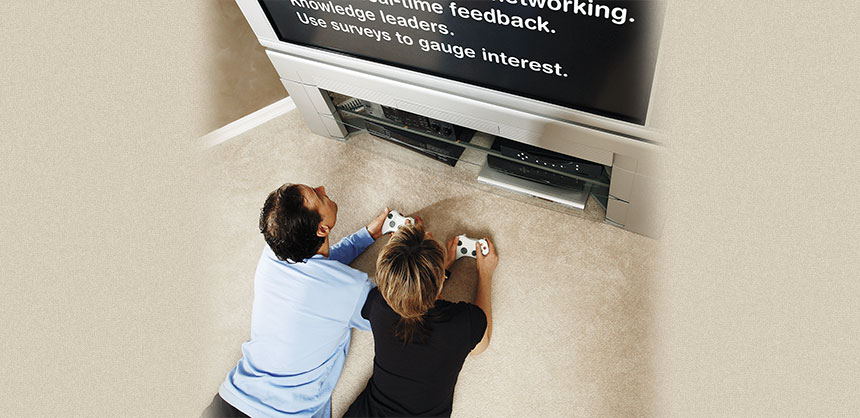Engaging Audiences Through GamificationJune 1, 2014
By Aaron PriceEngaging Audiences Through Gamification

 Aaron Price is the cofounder of livecube, the world’s most engaging event app used by many Fortune 1000 companies. He’s also the founder of the the award-winning NJ Tech Meetup, New Jersey’s largest tech community. With an early entrepreneurial drive sparked when awarded a patent in high school, he went on to found deliverU, effordables and weCraft. Price lives in Hoboken, New Jersey, with his wife and their two proudest startups, their two daughters.
Aaron Price is the cofounder of livecube, the world’s most engaging event app used by many Fortune 1000 companies. He’s also the founder of the the award-winning NJ Tech Meetup, New Jersey’s largest tech community. With an early entrepreneurial drive sparked when awarded a patent in high school, he went on to found deliverU, effordables and weCraft. Price lives in Hoboken, New Jersey, with his wife and their two proudest startups, their two daughters.
Keeping an audience attentive and engaged is one of the most challenging tasks for any event organizer. The average attention span of adults is estimated to be about 10 minutes, a fraction of the time an average speech or presentation takes at most events.
Today, event organizers are turning to gamification to utilize technology and social media platforms to elicit excitement, interest and joy for attendees. These positive experiences incentivize interaction and keep participants attentive and contributive.
“Event organizers are turning to gamification to utilize technology and social media platforms to elicit excitement, interest and joy for attendees.”
Think about how people willingly subject themselves to extra layovers to earn more flight miles. The time, effort and inconvenience to engage in an otherwise unpleasant activity is motivated by the promise of a future reward that is very desirable and rewarding. Similarly, a lifeless speech or event could be as arduous as a long layover, but an injected incentive as attractive as extra flight miles could change the perception of attendees.
Game content is key to the successful execution of gamification in events. Information and processes must be easily graspable by the average attendee, but also have the quality and reward system to keep the thought leaders engaged and interested.
Here are some best practices to using gamification at events, and tips on picking the right kinds of incentives, and building deeper attendee engagement:
- Stay away from offering “stuff.” Most people give out physical objects as rewards although it is the least motivating. Granted, if you give away a million-dollar sports car to the most engaged participant in a two-hour presentation, you might yield some enthusiastic interest. But the typical gifts (especially cheap corporate gift sets) are not the way to increase engagement.
- Go with SAPS rewards. The best rewards can be categorized (in importance order) by SAPS— Status, Access, Power and Stuff. Status means recognition. The person receives a badge during game play for example, or their achievement allows them to take a two-hour lunch. Think outside of the box, beyond just the $5 ticket for a free airline drink. Perhaps the top participant earns the right to ask the first panel question or earns dinner with the renowned speaker, giving them access to an influential person. You can give active participants the power of three minutes with the microphone to talk about their work in the company and recent successes. People want to feel special and to acquire something worthwhile for their efforts, so focus on SAPS rewards to keep the audience engaged.
- Engagement for single events. Engagement rewards for one-off events need to be immediate and impactful — you only have one chance to grab their attention. Gamification in a single event needs to be relevant and allow attendees to complete the challenge within the session. Consider relevant trivia quizzes during the discussion to encourage engagement with the content and base incentives on participation levels.
- Event series engagement. A series of events that are tied together provide opportunities for deeper engagement. Smaller achievements can be gamified throughout a series of events so attendees can earn rewards as they progress through the series. Use technology to keep track of attendee retweets and other activities over time, so the top “interacters” can be rewarded at the end.
- Incentivize sharing and networking. People attend meetings and events to either find ideas or meet interesting people. Tie gamification to the act of sharing information through social platforms such as Facebook or Twitter. The technology enabling gamification needs to allow seamless connection to social sites in order to be used by busy attendees, and not distract them from the actual event. You also can incentivize networking by rewarding people for making connections with others, or making the sharing of virtual business cards a game in itself.
- Leverage real-time feedback. Event presenters can use new technology tools to monitor attendee engagement in real time. This allows them to maximize the impact of the event by marginalizing low-engagement content and promoting the topics that are stirring interest and inter-group discussions. Presenters who are giving multiple talks can use real-time feedback to refine their discussions so the next talk can be more engaging and productive.
- Knowledge leaders. If you see several people who are very engaged in the content (through observation of their sharing patterns or aptitude on quizzes), quickly accord them some form of recognition to spur them on. Utilize these people to help others in the group to understand the material, and give them a gamified “leader” status so they are proud of their deeper involvement. If you spot top thought leaders over several sessions, then perhaps these individuals can be recruited for special projects or tagged as management candidates.
- Use surveys to gauge interest. You can gauge engagement indirectly by looking at attendees’ sharing activity and conversations, or measure it directly through surveys. Gamification within the survey can make it fun and exciting for participants to offer their honest opinion. The standard questions such as “what did you learn today?” could be built into a game, with incremental rewards for answering multiple questions.
An important consideration before introducing gamification is to remember you aren’t looking to make your event into just a game. Gamification is a complement to the event experience, a way to present relevant incentives in a more engaging and fun context. It provides a simple yet compelling way to motivate and focus audience behavior while giving event organizers a more active audience and livelier event. In a way, gamifying the event experience can be seen as the proverbial dangling carrot, incentivizing engagement and maximizing audience participation of the attendees. C&IT








